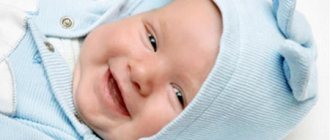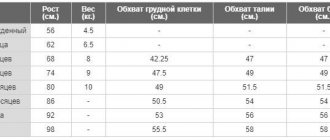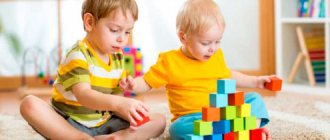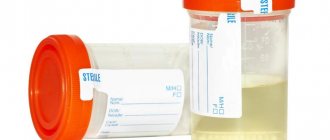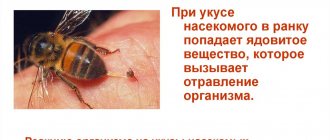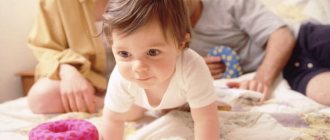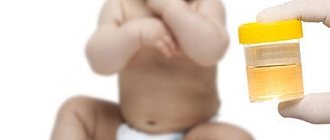What should a baby be able to do at two months of age?
- If placed on the stomach from the moment the navel heals, then, lying on the stomach, he can hold his head up for a couple of seconds, and also raise his chest.
- Able to hold his head while in the arms of an adult, he begins to look around, turning his head slightly.
- A reaction to the sound appears: with interest he searches for the source of the noise, but is frightened by loud sounds, shuddering with his whole body.
- The first smiles appear: this is a conscious reaction to a pleasant event (for example, the appearance of a mother). New facial expressions appear.
- Makes sounds in response to conversation: now parents can enjoy not only crying, but also the baby’s first “words”: chanting vowels, “cooing”, imitating the intonation of an adult.
- He begins to follow the toy and can distinguish moving objects from a distance of about 20 cm. It is still difficult for him to focus his gaze on an object in motion, but the first steps in the development of vision have already been taken.
- Coordination of movements improves, muscle hypertonicity disappears. After 2 months, the baby makes his first attempts to take possession of the toy that lies nearby. While this action is difficult for him, his hands do not obey, and his eye fails, but with persistent training, soon the first toy he grabs will be in his hand.
- Begins to study his body. When a child lies on his back, arms and legs sometimes catch his eye and arouse his interest. If you put a toy in your hand, he will also begin to study it: look at it, listen to sounds, suck.
Nutrition
Important! WHO does not recommend introducing complementary foods before 6 months when breastfeeding, and before 4 months when bottle-feeding.
When breastfeeding under normal conditions, the baby does not need any additional foods or additional drinks. Breastfeeding is considered the safest: it protects the child from diseases, allergies, caries, obesity, and there are fewer problems with stool. At 2 months, the baby should eat on demand, on average every 3 or 3.5 hours.
Exceptions when a baby requires water while breastfeeding: high body temperature of the baby; vomiting or diarrhea; in very hot weather (above 28 ºС).
When artificially feeding, the child must receive a special formula selected for him. If the mixture is not suitable, then allergic reactions are possible (rash, redness, appearance of a “milky crust” on the head), problems with stool (constipation, diarrhea, colic). Therefore, parents should carefully consider the choice of mixture; if the parents themselves are prone to allergies, then it is better to choose a mixture after consultation with an allergist.
With artificial nutrition, a child at 2 months should drink about 50 ml of water per 1 kg of baby’s weight. If the diet is mixed, then water should also be given, but subtracting the amount of breast milk drunk from the norm (to understand how much milk the baby drank, you can weigh him before and after feeding).
On our website there are also articles about the next months of the baby’s life, such as , , , , , , , , , months.
Formula method for determining height, growth formula
In children from 1 month to 6 months, normal growth is very easy and simple to determine.
3 M + PP, where M is the number of months of a child’s life, PP is height at birth. If the child is from 7 months to 12 months , then you can use the formula: M + 64, where M is the number of months of the child’s life. Normally, a child’s weight may differ by 2 cm, plus or minus, from the indicated values. That is, to the resulting figures ± 2 cm. For children older than 2 years to 8 years, the following formula is used to determine height in centimeters. 7 x L + 74, where L is the number of years of the child’s life. Normally, a child’s weight may differ by 3 cm, plus or minus, from the indicated values. That is, to the resulting figures ± 3 cm. For children over 9 years old to 16 years old, the following formula is used to determine height in centimeters. 5 x L + 90, where L is the number of years of the child’s life. Normally, a child’s weight may differ by 4 cm, plus or minus, from the indicated values. That is, to the obtained figures ± 4 cm.
Using the formulas provided by Sarklinik, it is easy to calculate the normal weight and height of any child at any age, but if it is difficult for you to do this yourself, we will help you. Below are examples of calculations for children of different ages, normal height and weight (mass) (table).
Mental changes
During this period, the child’s psychology changes significantly. The development of the emotional sphere is noticeable : the baby begins to recognize the voices of his relatives, rejoices at the arrival of his mother, he is pleased when they “coo” or play with him.
The child begins to “communicate” : he imitates the adult’s intonations and establishes eye contact.
The baby knows how to worry and express impatience : his arms and legs begin to move more actively, and the sound of crying changes.
At this age, the baby gives his parents the first expression of emotion - a smile. Every day he will master new facial expressions.
Children of the third year of life
Height and weight indicators do not change significantly between 2 and 3 years.
Over the course of a whole year, children can grow by only 6-7 cm and gain a little more than 1 kg in weight. Parameters of a child under 3 years old
| Months | Boys | Girls | ||
| Weight (g) | Height (cm) | Weight (g) | Height (cm) | |
| 25 | 12830 | 88,1 | 12220 | 86,7 |
| 26 | 12950 | 88,9 | 12380 | 87,5 |
| 27 | 13080 | 89,7 | 12520 | 88,4 |
| 28 | 13220 | 90,3 | 12680 | 89,2 |
| 29 | 13350 | 91,1 | 12820 | 90 |
| 30 | 13480 | 91,8 | 12980 | 90,7 |
| 31 | 13620 | 92,6 | 13110 | 91,4 |
| 32 | 13770 | 93,2 | 13260 | 92,1 |
| 33 | 13900 | 93,8 | 13400 | 92,9 |
| 34 | 14030 | 94,4 | 13570 | 93,6 |
| 35 | 14180 | 95 | 13710 | 94,2 |
| 36 | 14300 | 95,7 | 13850 | 94,8 |
Often, parents and grandparents, without noticing obvious changes in the baby’s height and weight, begin to literally feed him, which, of course, is fundamentally wrong. This tactic, observed in many families today, leads to more and more young children suffering from excess weight.
Daily regime
Normally, at two months, a baby sleeps about 80% of the day . It is not surprising that with so much sleep, a child can sometimes confuse day and night. In the first months this happened more often, after 2 months the situation should level out. If night games continue, then it is worth adding activity while awake: walks, games, bathing and massage will help the baby sleep soundly at night.
Pay attention to swimming! It mainly relaxes babies, so it is recommended to do it before bed. But there is a small percentage of babies who, on the contrary, are invigorated by bathing: it is better for these “little ones” to swim in the first half of the day.
SLEEP: about 16-18 hours, should sleep longer at night than during the day.
NUTRITION: on average, a child eats every 3-3.5 hours, but it is recommended to feed the child as required. There is no need to introduce additional complementary foods yet.
BATHING: a child at 2 months is already ready to swim. If parents support the idea of early swimming for babies or there is evidence, then a two-month-old swimmer can be taken to the pool: he is already able to move his arms and legs, but has not yet lost the skill of holding his breath under water. Bathing daily at home in a tub or large bathtub is also very beneficial.
MASSAGE: strengthens and relaxes the baby's muscles. It is necessary to massage daily for the proper development of the body and good functioning of the digestive organs.
WALKS: a source of health for the baby and a change of scenery for the mother. Normally, at 2 months, a child should walk for about two hours.
GAMES: Baby's first games develop skills already acquired and stimulate development. Stroking, tickling, “goat”, “peek-a-boo” - these and many other games are important for the development of the baby.
An example of a daily routine (the time is selected individually taking into account the baby’s sleep schedule):
- Waking up, feeding, toileting: about 30 minutes.
- Wakefulness, morning hygiene procedures: about 1 hour.
- 1 nap (can be combined with a walk): 2 hours.
- Feeding.
- Wakefulness: about 1 hour.
- 2nd day sleep: 2 hours.
- Feeding.
- Wakefulness: about 1 hour.
- 3 day sleep: 2 hours.
- Feeding.
- Wakefulness: about 1 hour.
- 4 day sleep: 2 hours.
- Feeding.
- Staying awake until nighttime sleep.
- Massage and gymnastics.
- Bathing: about 30 minutes for the entire procedure.
- Evening hygiene procedures.
- Feeding before bedtime.
- Night sleep.
- Night feedings (about 2 times per night).
Child 2 months, height and weight, normal height and weight for boys, girls at 2 months
For example, if a boy’s body weight at birth is 3600 g and his height is 52 cm, then at 2 months the following indicators should be normal.
Height 58 cm, weight 5200 g.
If a girl’s weight at birth is 2900 grams and her height is 48 cm, then at 2 months the following indicators should be normal.
Height 54 cm, weight 3800 g.
If you yourself cannot calculate the normal weight and height of your child online, ask the doctor a question absolutely free and within 3 days you will receive an answer not only about what the child’s normal development should be, but also how to find out the ratio of height and weight , why there is no gain, what to do in various situations, it is better to treat diseases, why a child does not gain weight, where to go for various diseases, how to find out the average weight of a child, what diagnostic methods should be used in specific cases, how a child can gain weight easily and quickly , what milk formulas to feed him. The Sarclinic doctor will try to help you. State as fully as possible all the complaints and problems that torment you.
When using this article, an active hyperlink to the website sarclinic.ru is required! Text: ® SARCLINIC | Sarclinic.com \ Sarсlinic.ru Photo: © marchibas / Photobank Photogenica / photogenica.ru The people depicted in the photo are models, do not suffer from the diseases described and/or all coincidences are excluded.
TREATMENT OF CHILDREN'S DISEASES IN SARCLINIC
ARTICLES ABOUT DISEASES IN CHILDREN
REVIEWS ABOUT TREATMENT OF CHILDREN IN SARCLINIC
Sign up for consultation. There are contraindications. Specialist consultation is required.
Related posts:
Why does a child feel bad, doesn’t speak much, doesn’t speak, how to teach a child to speak, talk
Enuresis in girls, treatment of enuresis in girls, nocturnal, daytime enuresis
Nocturnal enuresis, sleep enuresis, bedwetting, treatment, enuresis in children, in adults
The child stutters, began to stutter, began to stutter, what to do
Puberty boys, girls, teenagers, adolescence, puberty
Comments ()
Doctor Komarovsky

It may develop at a different pace, and that is absolutely normal. The parents' task : to do everything so that the child develops normally, and systematically show the child to specialists, to whom grandmothers on the street do not belong.
There are only general indicators of health: mood, behavior, appetite. The child does not owe anything to anyone. Each child develops individually. But there are general tips that a parent who wants their child to be healthy should take into account.
About the children's room:
The optimal temperature for the room where the child is is 18-20 ºС, humidity is 60-70% . To create a “healthy” atmosphere in the house, it is worth installing a humidifier and air conditioner in the children’s room and ventilating the room in a timely manner.
About food:
Starting complementary feeding before 4 months is unacceptable .
The likelihood of colic increases with overfeeding and overheating. It is not necessary to adjust the mother’s diet, but to reduce the amount of food.
About healthy sleep:

The child's daily routine should be adjusted to the family's daily routine, and not vice versa.
The optimal place to sleep is a crib in the parents' bedroom. Dr. Komarovsky does not recommend sleeping together in the same bed.
Avoid excess sleep! You can safely wake up the sleepyhead if he falls asleep. At 2 months, the sleep norm is from 16 to 20 hours.
Up to three months, a child can eat 1-2 times a night.
The child should sleep on a firm and flat mattress without pillows.
About swimming:
The child should bathe in a large bath, in cool water. The optimal temperature from birth is 37 ºС. The temperature should gradually decrease.
About hygiene:
Important! It is not recommended to clean your ears and nose with cotton swabs too zealously.
Ears : after bathing, wiping the auricle will be enough. If the wax is on the visible part of the ear, then it is removed with a cotton swab dipped in saline solution. Do not push the cotton swab deep, just wipe the wax in the visible part of the ear.
Nose : it’s easier to prevent crusts from forming than to get them out later. To do this, you need to maintain sufficient humidity in the room.
About diapers:
To swaddle or not to swaddle is a personal matter for parents. If swaddling saves mom, dad, grandma, and those around you from unnecessary worries, you can swaddle; if swaddling scares you, giving up diapers won’t do any harm.
About the sling:
Carrying in a sling is not harmful, if in moderation. The measure is two to three hours a day. And then, first of all, the restriction is associated with the load on the mother’s back.
Why do some grow faster than others?
Often, a child's height and weight are determined by genetic factors. If both parents are quite tall, then their baby will most likely be tall. The same goes for weight, but nutrition also plays a huge role here. A child whose parents are overweight may have a high predisposition to be overweight. Moreover, if he eats properly, then his weight can remain within normal limits. And, conversely, children who are not genetically predisposed to weight gain, even eating abundantly, may well remain thin.
Favorable living conditions (cleanliness and care), proper daily routine, daily walks, physical activity, etc. are of great importance for the proper development of children.
Personal hygiene: caring for a boy and a girl
Practically does not change compared to the neonatal period.
- Wipe your eyes with a cotton pad moistened with clean water.
- Clean your nose (if necessary, rinse, remove mucus or crusts with a cotton swab - it is not safe to penetrate deep into the nose).
- Clean the visible part of the ear canal, wipe the auricle.
- Trim nails as needed: the child should have separate nail scissors, preferably with rounded tips.
- Mandatory washing after defecation: it is convenient to wash boys in any direction, girls - only in the direction from the pubis to the butt. You need to wash it with your hands, with clean running water (temperature about 36 ºС). Soap and other cosmetics can be used no more than once a day, preferably a couple of times a week. Wet wipes can be used when clean running water is not available.
- Bath daily, rinsing all folds with water. Use soap no more than a couple of times a week.
Educational games

The purpose of games at this age is to consolidate the skills already acquired and promote the development of new ones, training muscles, vision, hearing, and touch.
“Goat”: the parent slowly moves up the hand with two fingers, slightly tickling. This teaches the child to feel his body.
Tummy time: a daily exercise that teaches your baby to hold his head up and lift his shoulders.
Touching with different fabrics: teaches the child to perceive different touches.
Observation of toys: the parent holds the toy at a distance of 20 cm from the child’s face from side to side, the child watches carefully.
Rocking on a fitball (large ball): a diaper is spread over the large ball, and the baby is placed on top of the tummy. The parent holds the child by the back and gently rocks the ball back and forth, from side to side. Perform all movements carefully. Good for the digestive system and muscle training.
“Where is the rattle, toy?”: ring the rattle or toy to the side not far from the child, wait until he finds the object. Then ring in another place and wait for a reaction again.
Games with fingers: place various toys, rattles, sticks, balls in the hand, stimulating the development of tactile sensitivity in the palm and training the fingers.
Common problems
Digestive problems

In addition, it is worth monitoring the mother’s diet if the child is breastfed (keep a food diary, identify which foods cause a reaction), and select the right formula if the child is bottle-fed.
In order for the digestive system to function smoothly, the child needs activity: massage, bathing, gymnastics, laying on the stomach, “swinging” on a fitball.
If your tummy already hurts, then you should try: stroke your belly clockwise; put a warm diaper on your tummy; place the baby on the mother's stomach.
Important! Use products with simethicone after consultation with your pediatrician.
How often should a child fill a diaper? A routine for going to the toilet has not yet been established. If nothing bothers the child, he does not cry, does not blush too much, there is no bloating, then everything is fine. At this age, even the fact that a child does not go to the toilet for a week should not cause panic: breast milk is digested, and it is possible that the baby sucks quite a bit of it.
Weak muscles (cannot hold head up)
Perhaps the baby is not ready yet. At the age of 2 months, the child is just beginning to master this skill. It’s too early for parents to worry about this, but you can put him on his stomach more often, put something interesting at such a distance that he has to raise his head.
Rash, redness
A skin rash and redness should alert parents and be a reason to contact a pediatrician. Don’t be alarmed: it could be a “bloom” that will disappear over time, or a “sweating rash” that goes away quite quickly if the room is cooler and the child is kept naked more often.
But allergic reactions also occur, so it is better to consult a specialist: he will help adjust the mother’s diet if the child is breastfed, or choose the right formula if the baby is “artificial”.
To reduce itching, it will be useful to bathe your baby in the bath with the addition of chamomile decoction: this will help relieve inflammation.
Nutrition is the main reason
Doctors say that the very first reason for underweight or, conversely, excess weight, as well as non-compliance with age norms in growth indicators, is improper and unbalanced nutrition. If it comes to an infant, then deviations in physical development (primarily weight) may be the result of artificial feeding. A mother who is not dependent on her own milk makes the formula more concentrated or feeds the baby more often than necessary. As such children grow up, they lag behind their peers in motor skills - later they begin to sit, crawl and walk. They are also more likely to get colds and allergies.
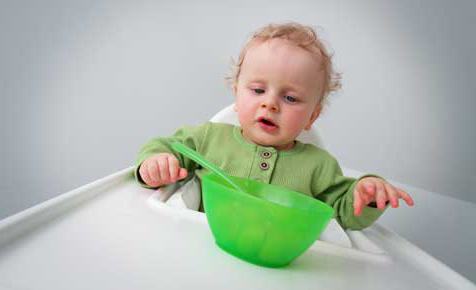
In some families, unfortunately, children still suffer from malnutrition to this day. As a rule, these are dysfunctional families in which parents, for one reason or another, cannot provide the child with food adequate for his age. Children do not receive enough vitamins and calcium, which affects their growth and general well-being.
